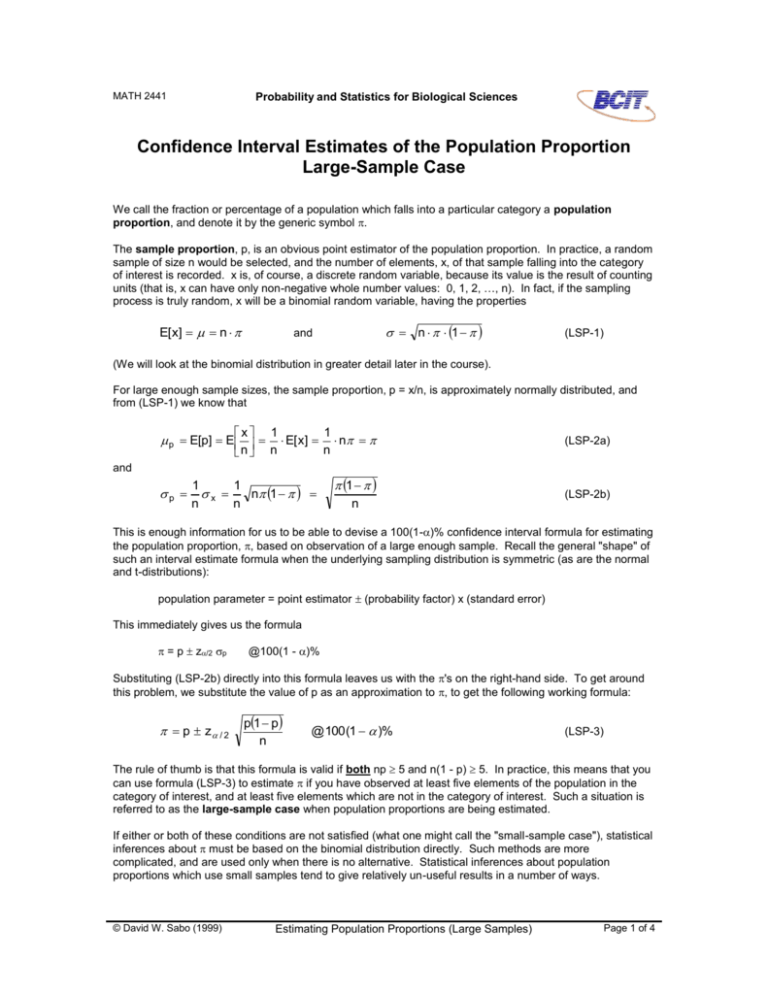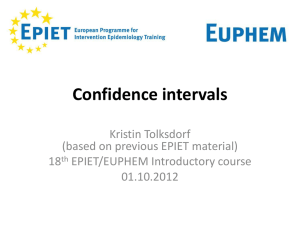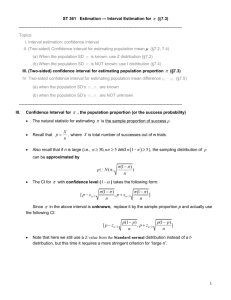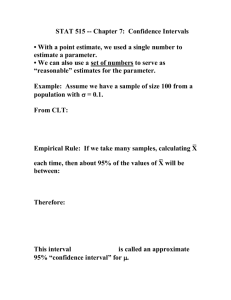here - BCIT Commons
advertisement

MATH 2441 Probability and Statistics for Biological Sciences Confidence Interval Estimates of the Population Proportion Large-Sample Case We call the fraction or percentage of a population which falls into a particular category a population proportion, and denote it by the generic symbol . The sample proportion, p, is an obvious point estimator of the population proportion. In practice, a random sample of size n would be selected, and the number of elements, x, of that sample falling into the category of interest is recorded. x is, of course, a discrete random variable, because its value is the result of counting units (that is, x can have only non-negative whole number values: 0, 1, 2, …, n). In fact, if the sampling process is truly random, x will be a binomial random variable, having the properties E[ x] n n 1 and (LSP-1) (We will look at the binomial distribution in greater detail later in the course). For large enough sample sizes, the sample proportion, p = x/n, is approximately normally distributed, and from (LSP-1) we know that x 1 1 p E[p] E E[ x] n n n n and p 1 1 x n 1 n n 1 n (LSP-2a) (LSP-2b) This is enough information for us to be able to devise a 100(1-)% confidence interval formula for estimating the population proportion, , based on observation of a large enough sample. Recall the general "shape" of such an interval estimate formula when the underlying sampling distribution is symmetric (as are the normal and t-distributions): population parameter = point estimator (probability factor) x (standard error) This immediately gives us the formula = p z/2 p @100(1 - )% Substituting (LSP-2b) directly into this formula leaves us with the 's on the right-hand side. To get around this problem, we substitute the value of p as an approximation to , to get the following working formula: p z / 2 p1 p n @ 100 (1 )% (LSP-3) The rule of thumb is that this formula is valid if both np 5 and n(1 - p) 5. In practice, this means that you can use formula (LSP-3) to estimate if you have observed at least five elements of the population in the category of interest, and at least five elements which are not in the category of interest. Such a situation is referred to as the large-sample case when population proportions are being estimated. If either or both of these conditions are not satisfied (what one might call the "small-sample case"), statistical inferences about must be based on the binomial distribution directly. Such methods are more complicated, and are used only when there is no alternative. Statistical inferences about population proportions which use small samples tend to give relatively un-useful results in a number of ways. © David W. Sabo (1999) Estimating Population Proportions (Large Samples) Page 1 of 4 Reasonable precision and reliability in estimating population proportions almost certainly requires the use of large samples. Example 1: In a letter to the editor (Nature, 396, p. 531) discussing an earlier report of increased susceptibility to cervical cancer by women who were homozygous at codon-72 of the p53 gene, A. M. Josefson and her coauthors reported on frequencies of the Pro/Pro, Pro/Arg and Arg/Arg codons. They found that 246 out of a sample of 626 women with no diagnosis of cervical cancer were heterozygous at this site. Compute a 95% confidence interval estimate of the proportion of all cancer-free women who are heterozygous at this site, based on this sample data. Solution: The proportion of women in the sample who were heterozygous at this site is simply p 246 0.393 626 Since in the sample of 626 women, there were 246 who were heterozygous, there must have been 626 - 246 = 380 women who were not heterozygous (ie. homozygous). Since both of these numbers are bigger than 5, we are justified in using the large-sample formulas given above. For a 95% confidence interval estimate, we need z.025 = 1.96. Thus, the required estimate is 0.393 1.96 (0.393 )(1 0.393 ) 626 0.393 0.038 @ 95% You could also write this is the form 0.355 0.431 @95% indicating that there is a probability of 0.95 that the interval 35.5% to 43.1% has captured the value of the actual proportion of the population of all women without cancer who are heterozygous at this site. Deciding on Appropriate Sample Sizes As with confidence interval estimates in general, the confidence interval estimates of the population proportion given by formula (LSP-3) above contains an "uncertainty" term which represents the precision of the estimate, and which has a value dependent on both the value of the population proportion, and the sample size. The appropriate sample size to use is thus determined in part by the precision desired in the estimate to be obtained and in part by what one expects the value of the population proportion may be. To obtain an interval estimate with a precision of, say, , we need to select a sample of size n, where n satisfies the following equation: z / 2 1 n z / 2 p1 p n (The exact equation is the one with 's on the left-hand side, but in the confidence interval formula given earlier, we approximate by the known value of p. However, before the sampling has been done, we don't have a value for either or p, so it doesn't much matter which of these two equations you work with.) Solving for n, we get n Page 2 of 4 z 2 / 2 1 2 Estimating Population Proportions (Large Samples) (LSP-4) © David W. Sabo (1999) All that remains is to decide what to do about the unknown on the right-hand side here. There are two distinct approaches. First, you could carry out a relatively small pilot study, and use the sample proportion, p, that you get from that data as a rough estimate of in formula (LSP-4). Example 1a: Approximately what size of sample would the researchers described in Example 1 above had to have used if they wished to get a 95% confidence interval estimate of the proportion of heterozygous women which was accurate to within 0.01 (or 1 percentage point). You may use the fact that the population proportion appears to be approximately equal to 0.40 based on the reported studies. Solution: We are asked to recommend a minimum value of n given = 0.01 and 0.40. Substituting these values and the value z.025 = 1.96 into formula (LSP-4), we get n 1.96 2 0.40 0.60 0.012 9219 .84 This indicates they would have to sample 9220 or more women to be able to achieve the stated precision of estimate. What's worse, even if they include 9220 women in their sample, they could still miss their target precision if the resulting value of p was not 0.40. For example, if after sampling 9220 women, they obtained a sample proportion equal to, say, 0.43 (which is near the upper end of the confidence interval estimate obtained in Example 1, and so is not beyond the realm of possibility), then their new estimate of would turn out to be: 0.430 1.96 (0.430 )(1 0.430 ) 9220 0.430 0.0101 @ 95% The '' term here is not a great deal larger than 0.01 (in fact, this overage would probably be of no practical significance at all in real work), but still, it is larger than 0.01. The estimate of 9220 as a required sample size was not a guarantee. There is a second approach to estimating appropriate sample size: we could call it the pessimistic approach. The difficulty here is that the value of n given by (LSP-4) is directly proportional to (1 - ). The bigger the value of this product, the bigger the required value of n to achieve a target value for . However, by looking at a graph of y = (1 - ) as a function of , you can see that this product has a maximum value that occurs when = 0.5. The uncertainty term in the confidence interval formula is largest when =0.5, and so if we pick n to achieve a certain value of when =0.5, we will be guaranteed that the uncertainty term will be less than or equal to that value of regardless of the value of p obtained from the sample. Thus, the pessimistic approach says: use n given by the first whole number larger than 0.25 z 2 / 2 2 y = (1-) 0.25 0.20 0.10 0 0.5 1 (LSP-5) Example 1b: What sample size is suggested for the study described in Example 1 if we use this most pessimistic approach, but still wish to get a 95% confidence interval estimate precise to the nearest 0.01? © David W. Sabo (1999) Estimating Population Proportions (Large Samples) Page 3 of 4 Solution: Just plug z.025 = 1.96 and = 0.01 into (LSP-5) and round up to the nearest whole number: 0.25 1.96 2 0.012 9604 Actually, no rounding was necessary here. Thus, if a sample of size 9604 was used, the estimate of is guaranteed to come out precise to within 0.01 or 1 percentage point. The disadvantage of the pessimistic approach is that, of course, you may end up collecting data from a far larger sample than was necessary, which would normally mean that you spent more money on the study than was necessary. For instance, if the sample of size 9604 was found to have a proportion of 0.400 women who were heterozygous at this site on the p53 gene, then the interval estimate of would turn out to be 0.400 1.96 0.400 0.600 0.400 0.0098 9604 @ 95 % It's not so much that this is slightly more precise than was desired, but that this small (and unnecessary) additional precision required sampling nearly 400 extra individuals. One last comment before leaving this issue of sample sizes: notice that for populations that are fairly evenly split between two categories, 0.5, we require really quite large samples in order to achieve 1 percentage point accuracy at a 95% confidence level. From looking at the graph just above, you may think this will not be as big a problem for values of near zero or 1. For values near 1, it isn't, but for values near zero, the problem is even worse to get the same relative precision. For this reason, it is relatively rare to attempt estimates of population proportions which are much more precise than 0.03 or 0.04, unless some unusual aspects of the experiment require higher precision. (You may notice that when newscasters report the results of political polls, they often explain that the numbers they give are "accurate to within 4 percentage points, 19 times out of 20" this means the sampling provided a 95% confidence interval estimate with a precision of 0.04.) Page 4 of 4 Estimating Population Proportions (Large Samples) © David W. Sabo (1999)









